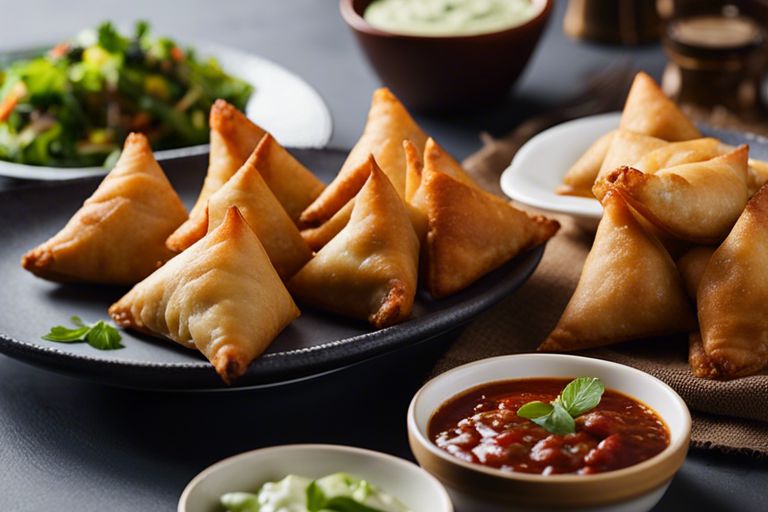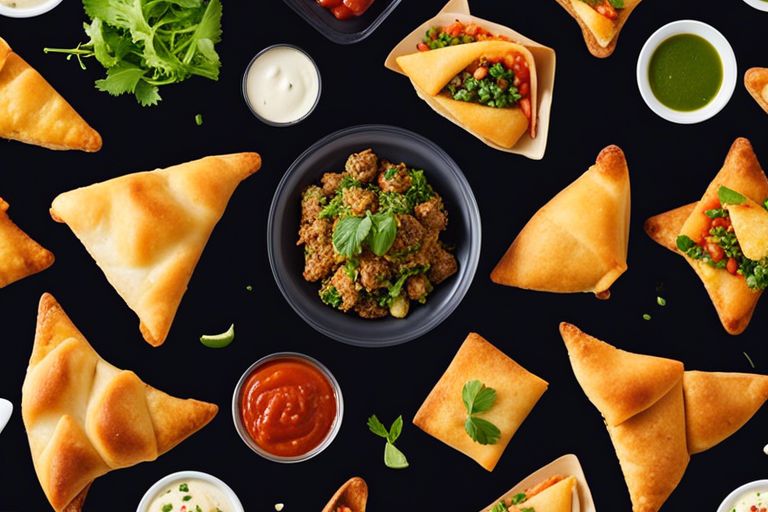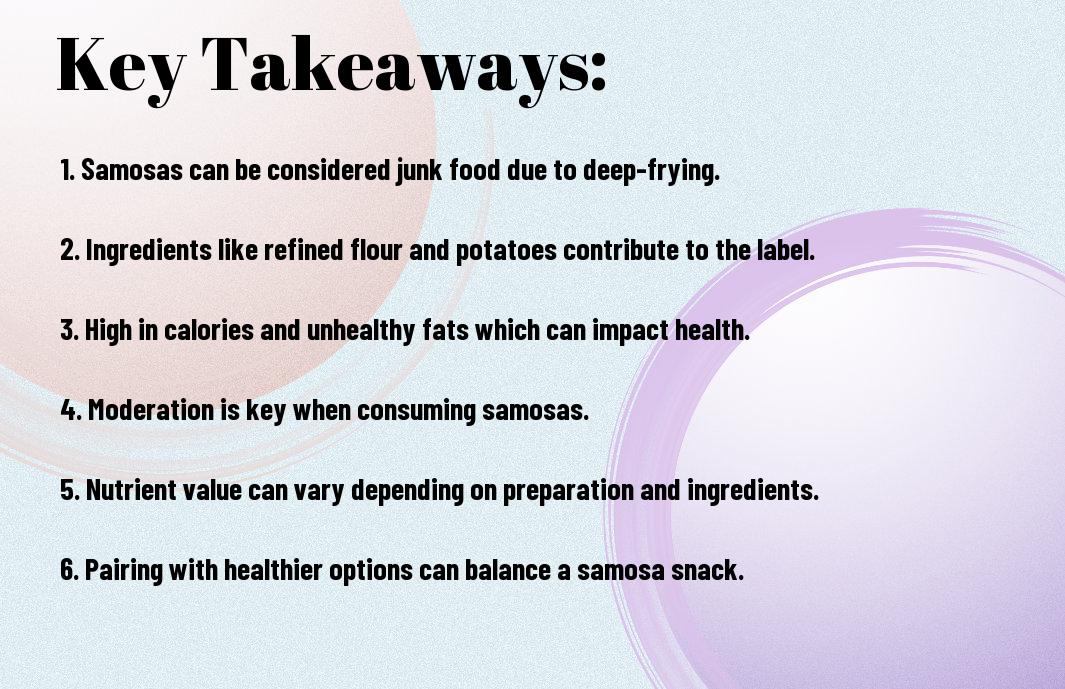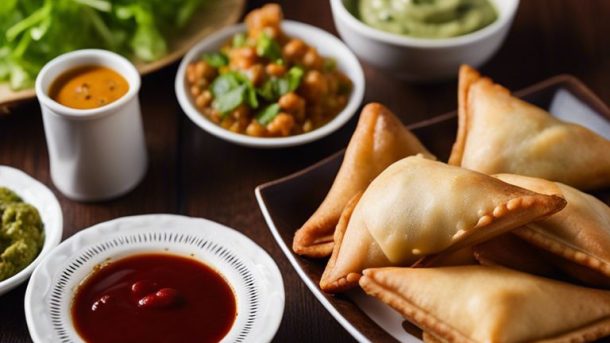Junk food cravings can often lead you to wonder about the nutritional content of popular snacks like samosas. While undeniably delicious, samosas can be categorized as junk food due to their high fat and calorie content. Fried to crispy perfection and filled with spiced potatoes or meat, samosas may not be the healthiest choice for your diet. However, enjoying one occasionally as a treat is perfectly fine, just remember to balance it with healthier options in your meals.
Key Takeaways:
- Samosa is a deep-fried snack: Samosas are typically deep-fried in oil, which increases their calorie and fat content, making them a less healthy choice.
- Nutritional content varies: The ingredients used to make samosas can vary, so the nutritional content may vary as well. Some versions may have more veggies and less oil, making them healthier.
- Enjoy in moderation: While samosas can be delicious, they are generally considered a type of junk food due to their high calorie and fat content. It’s best to enjoy them in moderation as part of a balanced diet.

Defining Junk Food
A Samosas versus burgers: The Great Indian Dilemma is a common debate when it comes to categorizing foods as junk or not. But what exactly qualifies as junk food? Junk food is typically defined as food that is high in calories, sugar, salt, and unhealthy fats, while being low in nutritional value. These foods often provide little to no benefits in terms of vitamins, minerals, or other important nutrients that your body needs to function properly. Instead, they are usually packed with empty calories that can lead to weight gain and various health issues.
Characteristics of Junk Food
On top of being high in unhealthy components such as sugar and saturated fats, junk food is also often processed and refined, stripping away any potential nutritional value. Additionally, junk food tends to be easily accessible, convenient, and affordable, making it a tempting choice when you’re in need of a quick snack or meal. The addictive nature of these foods, combined with clever marketing tactics, can also make it harder for you to resist indulging in them regularly.
Nutritional Value of Samosas
On the surface, samosas may seem like a tasty and satisfying snack option. However, when it comes to their nutritional value, they may fall into the category of junk food. Samosas are typically deep-fried, which can significantly increase their calorie and fat content. Additionally, the filling of samosas is often made with ingredients like potatoes and peas, which may not provide a wide range of important nutrients. While they can be a flavorful treat enjoyed in moderation, consuming samosas regularly as a staple part of your diet may not be the healthiest choice.
The key is to be mindful of your overall diet and make informed choices when it comes to the foods you consume regularly. While it’s okay to indulge in your favorite treats occasionally, relying on them as a significant portion of your diet can have negative effects on your health in the long run.
Historical Context of Samosas
Some people often wonder about the origins of samosas and how they have evolved over time. In this section, we will investigate into the historical context of this popular snack to shed some light on its interesting journey through the centuries.
Origins of Samosas
Samosas have a long and rich history that traces back to the Middle East before making their way to the Indian subcontinent. The earliest versions of samosas were believed to be triangular pastries filled with meat, vegetables, and spices. It is thought that these savory treats were introduced to India by traders or merchants traveling along the ancient Silk Road.
Evolution of Samosa Recipes
Samosas have undergone various transformations in terms of their fillings and shapes as they spread across different regions. From the traditional potato and pea filling in India to minced lamb or beef varieties in Middle Eastern countries, the diversity of samosa recipes reflects the fusion of cultures and culinary influences over time.
For instance, in Western countries, you may find unique interpretations of samosas filled with ingredients like cheese, spinach, or even sweet fillings like chocolate or fruit. This adaptability of samosas to suit different palates showcases the versatility and enduring popularity of this beloved snack around the world.

Nutritional Breakdown of Samosas
Calories and Macronutrients
Breakdown of the nutritional content of samosas shows that they are calorie-dense due to their fried pastry shell. A typical samosa can contain around 250-300 calories. The primary macronutrients in a samosa are carbohydrates and fats, with a smaller amount of protein.
Fat and Sodium Content
Calories in samosas come mainly from fats, as they are deep-fried. A single samosa can have 13-15 grams of fat, with a significant portion being saturated fats, which can raise your cholesterol levels. Additionally, samosas can be high in sodium, with one samosa providing around 300-400 milligrams of sodium.
This high fat and sodium content in samosas can lead to health issues such as weight gain, heart diseases, and high blood pressure if consumed in excess.
Presence of Additives and Preservatives
To enhance the taste and prolong the shelf life of samosas, manufacturers often add artificial additives and preservatives. These substances can include artificial colors, flavors, and preservatives like BHA and BHT. While these additives may improve the taste and appearance of samosas, they can be harmful to your health in the long run.
Presence of these additives and preservatives in samosas raises concerns about the overall nutritional quality and potential health risks associated with consuming these popular snacks regularly.
Comparing Samosas to Other Snacks
All information has its value, and when it comes to comparing samosas to other snack options, it’s imperative to understand how they stack up against popular choices. Let’s break it down for you in the following tables.
Samosas vs. Chips
| Samosas | Chips |
| Fried pastry with savory filling | Deep-fried potato or corn snacks |
| Contains vegetables and spices | Often high in salt and unhealthy fats |
Samosas vs. Cookies
| Samosas | Cookies |
| Savory snack with a mix of flavors | Sweet treat with high sugar content |
| Typically fried but can be baked for healthier option | Often high in sugar and unhealthy fats |
The comparison between samosas and cookies boils down to your preference for sweet or savory snacks. While cookies tend to be higher in sugar, samosas can be fried which may increase their calorie content. Ultimately, the choice between the two depends on your taste preferences and dietary considerations.
Samosas vs. Fresh Fruits
| Samosas | Fresh Fruits |
| Savory fried pastry with filling | Natural, wholesome snack packed with vitamins and fiber |
| Higher in calories and fats | Low in calories and high in nutrients |
It is clear that fresh fruits offer a healthier alternative to samosas due to their nutritional value and lower calorie content. While samosas can be enjoyed in moderation as a tasty treat, incorporating fresh fruits into your snacking routine can provide imperative vitamins and minerals for your overall well-being.
The Role of Samosas in Modern Diets
Convenience and Accessibility
Unlike some other traditional foods, samosas are widely available and convenient to eat on the go. You can find them in many fast food restaurants, food stalls, and even supermarkets. This easy access makes them a popular choice for a quick and satisfying snack when you are out and about.
Cultural Significance and Emotional Connection
For many people, samosas hold a special place in their hearts as a reminder of cultural traditions and family gatherings. The process of making samosas can be a bonding experience, with generations coming together to prepare and enjoy these delicious treats. The familiar taste of a samosa can evoke feelings of nostalgia and comfort, making them more than just a snack.
The cultural significance of samosas extends beyond just the taste. They often feature prominently in celebrations and festivals, symbolizing unity and happiness. Whether you are enjoying a samosa at a party or simply craving a taste of home, these savory pastries can bring a sense of belonging and connection.
Impact on Health and Wellbeing
For many, samosas are considered a high-calorie, deep-fried indulgence that may not align with a balanced diet. While they are undeniably delicious, it is important to enjoy them in moderation to avoid potential health consequences. The fried pastry shell and often spicy filling can be heavy on the stomach and lead to digestive discomfort if consumed excessively.
However, you can make healthier choices when it comes to samosas by opting for baked instead of fried versions or incorporating more vegetables and lean protein into the filling. By being mindful of your samosa consumption and balancing it with other nutritious foods, you can still enjoy this tasty snack without compromising your health goals.
Debunking Myths and Misconceptions
Samosas as a Healthy Snack Option
To address the misconception of samosas being categorized as junk food, it’s important to understand that they can actually be a healthy snack option when prepared and consumed mindfully. Your perception of samosas as unhealthy may stem from the typical deep-fried preparation found in many fast-food outlets. However, by opting for baked or air-fried samosas made with wholesome ingredients like vegetables, lean proteins, and whole wheat flour, you can enjoy a nutritious and satisfying snack.
The Misconception of Samosas as a Traditional Food
Traditional samosas are an integral part of various cuisines around the world, including Indian, Middle Eastern, and African culinary traditions. While they are commonly enjoyed as street food or appetizers, their roots go back centuries, making them a cherished dish with cultural significance. When prepared at home using fresh ingredients and spices, samosas can serve as a delicious representation of traditional cooking methods and flavors.
Myths surrounding samosas often disregard their historical and cultural importance, reducing them to mere unhealthy indulgences. In reality, samosas reflect the culinary diversity and richness of traditional diets across different regions, highlighting the intricacies of flavor profiles and cooking techniques that have been passed down through generations.

Summing up
So, when it comes to the question “Is samosa junk food?”, the answer is both yes and no. While samosas can be considered a type of junk food due to their deep-fried nature and high calorie content, they also offer some nutritional value with their mix of vegetables, spices, and carbohydrates. Do not forget, moderation is key when it comes to enjoying samosas as part of your diet. Be mindful of portion sizes and try to balance your intake with healthier food options to maintain a well-rounded diet.
FAQ
Q: Is samosa considered junk food?
A: Samosa is often categorized as junk food due to its high calories, fat, and sodium content. It is deep-fried and made with refined flour, which makes it an unhealthy choice if consumed in excess.
Q: What makes samosa unhealthy?
A: The high amount of oil used in frying samosas increases their calorie and fat content significantly. Additionally, the outer pastry shell of samosas is made from refined flour, adding empty calories without providing much nutritional value.
Are there any healthier alternatives to traditional samosas?
A: Yes, you can make healthier versions of samosas by baking them instead of frying, using whole wheat or multigrain flour for the pastry, and filling them with a mix of vegetables and lean protein like chicken or tofu. These modifications can make samosas a better choice for those looking to enjoy this snack in a healthier way.


